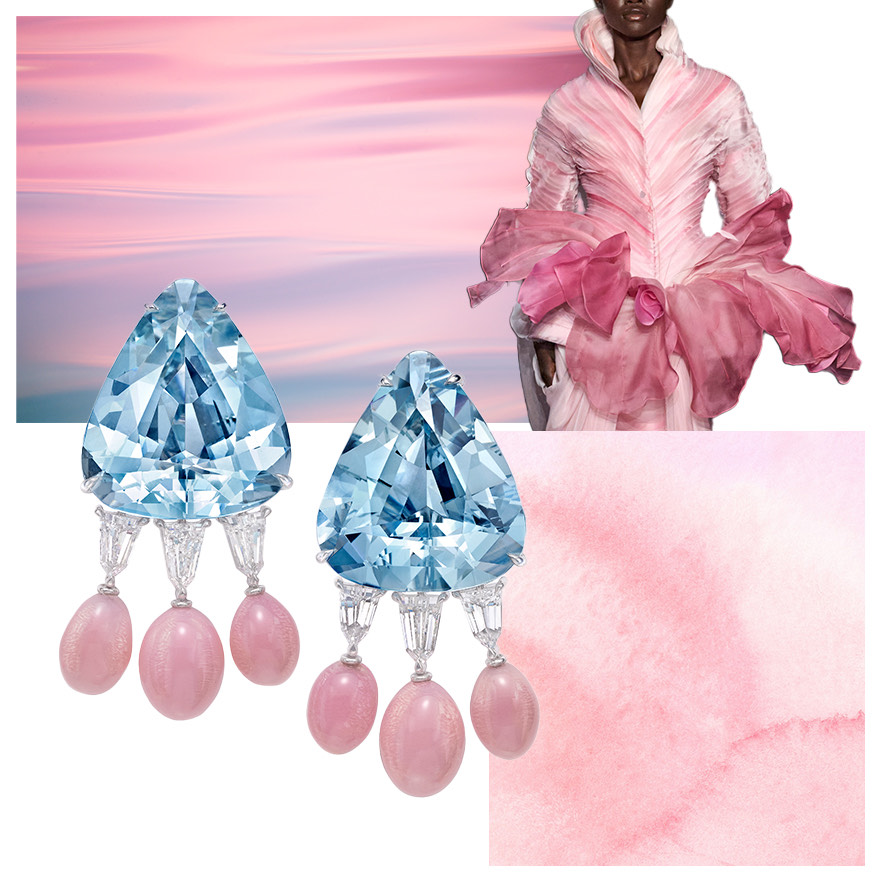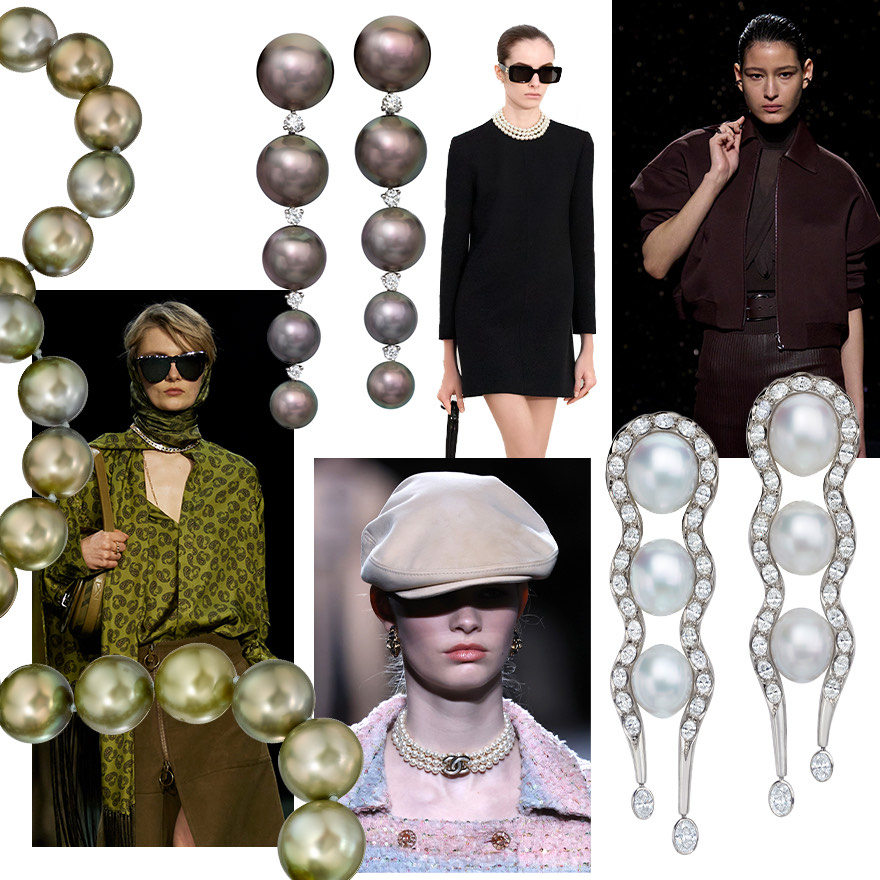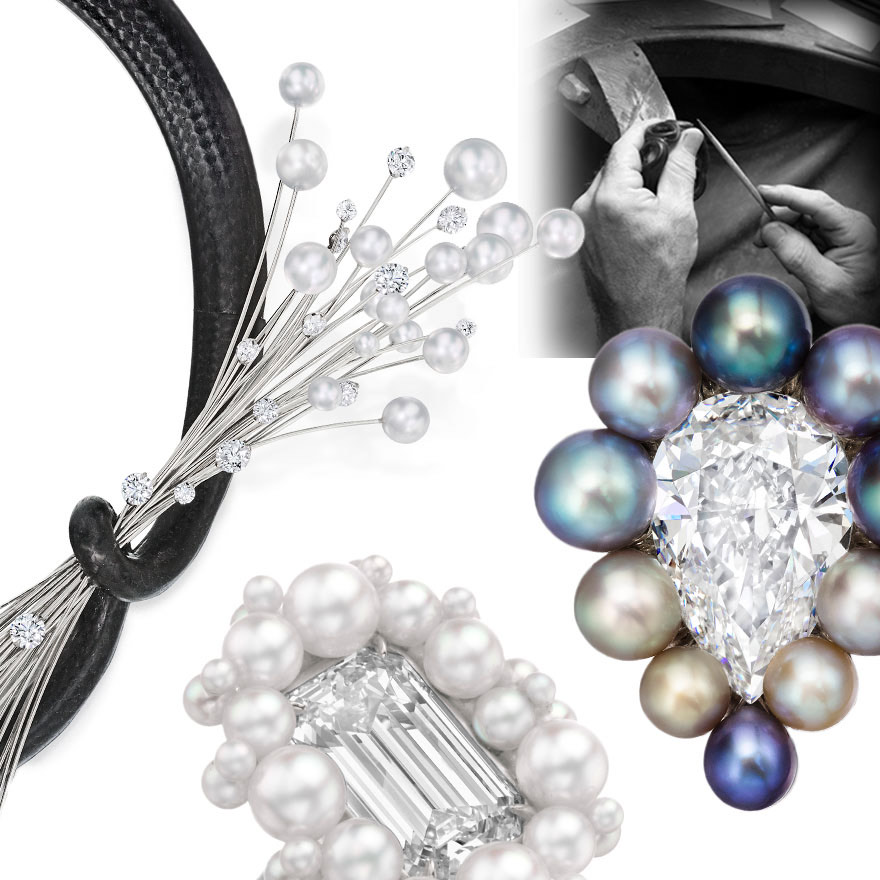
Akoya vs South Sea Pearls – How to Choose the Perfect Strand
Pearls are not only the most prolific accessory in fashion these days, they are also unisex, sustainable, meaningful, and enduring – offering a lifetime of beauty, warmth, and glow to the person who wears them. The current haute couture and pop culture affinity for pearls has many folks shopping for pearl strands. Pearl shoppers, though, are often confused by the differences between Akoya Pearls and South Sea Pearls and which they should choose for their own classic white pearl strand. If you are seeking a pearl strand as a significant and meaningful piece of jewelry and shopping for a classic, beautiful white strand, it is important to familiarize yourself with the different pearl varieties and to understand each a little better. This will help you decide whether you want to shop for Akoya or South Sea Pearls, and it will ultimately help you choose the perfect white pearl strand.
White Pearl Types

There are four types of white pearls – Natural Pearls, Freshwater Pearls, Akoya Pearls, and South Sea Pearls.
Natural Pearls were first found in 5,800 B.C. They are exceedingly rare. Some of the beautiful round Natural Pearls with very high luster have sold for hundreds of thousands of dollars (sometimes millions) at auction. That is, of course, when they are beautiful. But very few of the Natural Pearls found in today’s industrialized world are beautiful.
Freshwater Pearls are produced by a type of mussel (rather than an oyster) in a fresh water source like a lake or a river. These pearls can be found as low as $50 or $79 per strand. Assael does not carry Freshwater Pearls because they usually have a much thinner layer of nacre (nacre is the outside of the pearl that you see, the substance which gives the pearl luster). Their nacre is thin because the mussel is left to grow or complete the pearl in only weeks or months (versus the years it takes to grow a South Sea or some of the larger Akoya Pearls). Because they have a much larger nucleus to nacre ratio, Freshwater Pearls can often change their look after being worn for a relatively short period of time, another reason for Assael to avoid them. Freshwater Pearls can be a good alternative for a much lower budget, starting around $50.
The beautiful forever strand of fine white pearls that most people are shopping for, to have and wear forever, would be one of the other two varieties … Akoya Pearls and/or South Sea Pearls.
Here, we will explore some of the important distinctions between Akoya and South Sea Pearls to help you understand how to choose the best pearl strand for yourself. It helps to consider these two classic types of pearls by their characteristics – size, origin, shape, and color.
SIZE RANGES of Akoya and South Sea Pearls
The first and most important difference between Akoya and South Sea Pearls is SIZE RANGE.
Japanese Akoya Pearls come in sizes from 2 mm to 10.5 mm (millimeters). A size below 5 mm, when strung, is too small to be considered a strand and appears more like a thin chain. The smallest sizes are often known as “seed pearls.”
The other extreme for the Akoya Pearl’s size range is 10 to 10.5 mm, which in high quality, is VERY rare. Given their rarity, these larger Akoya Pearls are disproportionately more costly than the increases in diameter size from 5 to 6 to 7 to 8 to 9 mm. To reach normal sizes for Akoya Pearls (5 – 9 mm in diameter), an oyster must be left in the ocean to grow the pearl for roughly 10 – 18 months. The rare larger Akoyas measuring 10 to 10.5 mm can take up to two years to grow.
South Sea Pearls, on the other hand, come in larger sizes because they grow in a larger genus of oyster (see more below). South Sea Pearls are typically between 8 mm to well over 20 mm. The vast majority of South Sea Pearls measure between 9 – 16mm.
ORIGIN of Akoya and South Sea Pearls
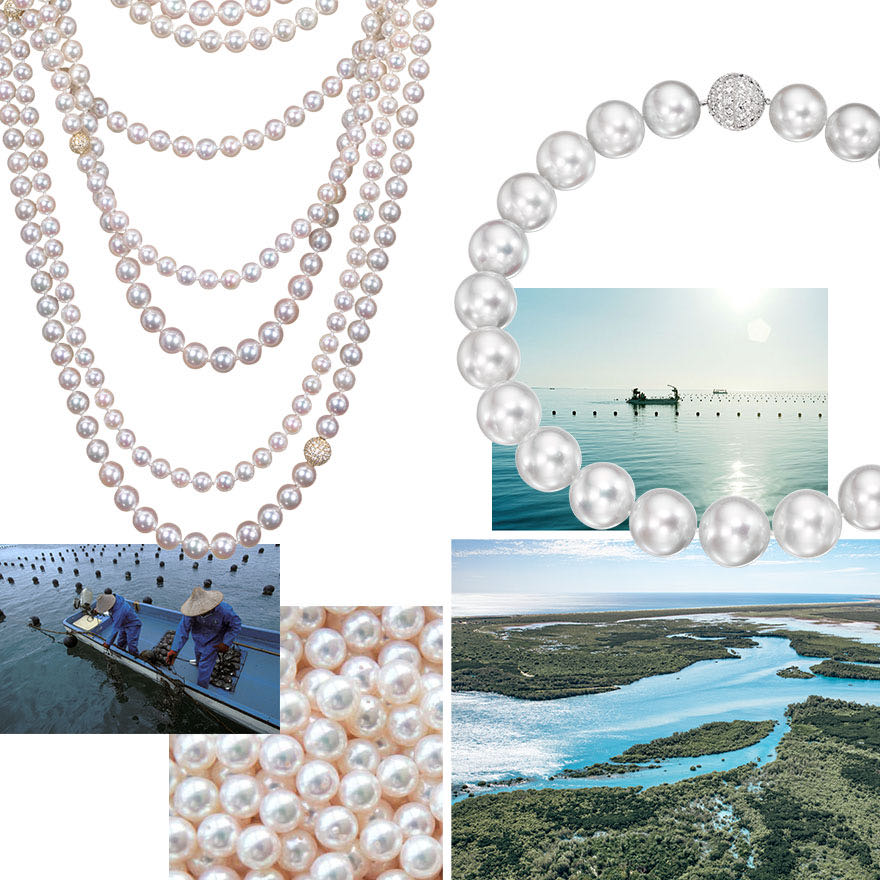
Different varieties of pearls come from different species of oysters which thrive in different parts of the world’s oceans.
Fine Akoya Pearls come from the Pinctada Fucata oyster which is cultivated and grown in bays off the coast of Japan. The Japanese street name for the Akoya oyster (Pinctada Fucata) is “Akoya Gai,” hence the name Akoya Pearl. In fact, the first pearls ever cultured were cultivated in Japan. Akoyas are known for their luster. They have the highest luster of all cultured pearls.
The vast majority of white South Sea Pearls come from locations off the coast of Australia. The oyster native to this climate, the Pinctada Maxima, is much larger than the Japanese Pinctada Fucata oyster. Because it is the largest oyster, it produces the largest of all pearls.
SHAPE – Round, Off Round, Baroque
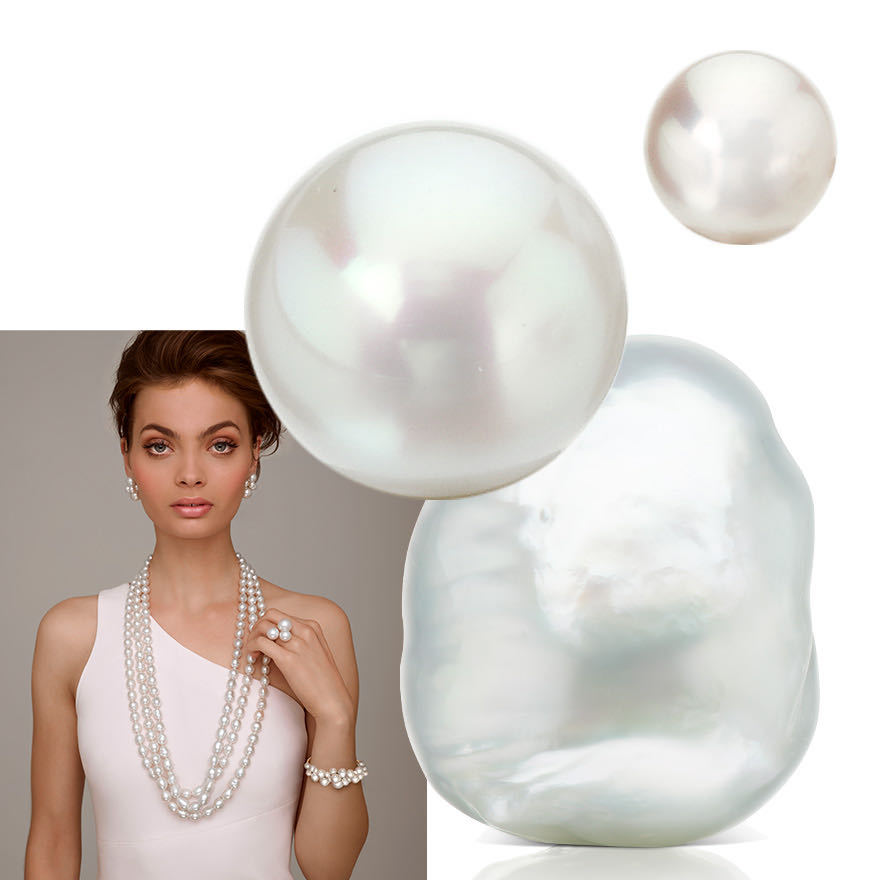
Certainly, not all Akoya Pearls are round, but a higher percentage are round or “off round” than those of South Sea Pearls. The very “off round,” organic shapes of all pearls are known as “baroque” pearls. Fine South Sea Baroque Pearls are much more valuable and desirable than Baroque Akoya Pearls. Because of the large size difference in the two primary varieties, a South Sea Baroque Pearl is more likely to have a critical mass of lustrous surface.
Very fine, large South Sea Baroques can be more valuable than smaller, lower luster round and off round shapes of South Sea Pearls.
COLOR of Akoya and South Sea Pearls
The classic Japanese Akoya Pearl is white with an undertone of pink or rosé. While Akoya Pearls can be silver to silver-blue, golden, and other colors, the classic strand or stud is always white in appearance. The Akoya strand is known as the “little black dress” of pearls. It is the classic white strand given for momentous occasions such as graduations, weddings, birthdays, and Valentine’s Day.
The South Sea oyster, on the other hand, produces many versions of white pearls – an almost pure white and whites with varying undertones of rosé, white, and/or champagne white. While there are colorful pearls from other locations in the “South Seas” such as Goldens from Indonesia and the Philippines, and gray to black Tahitian Pearls, the classic white South Sea strand is the aforementioned white or variation of white.
VALUE/COST/PRICE of Akoya and South Sea Pearls
To compare costs of Akoya and South Sea Pearls, it is important to do so within the same qualities of luster, shape, and cleanliness (or lack of blemishes).
The size factor is a bit more complicated. As mentioned above, these two varieties only overlap in size by 2 or 3 mm (between 8 and 10.5 mm). As an example, a fine 7 mm Akoya Pearl will obviously cost less than a fine 12 mm South Sea Pearl; however, from 9.5 – 10.5 mm (the overlap), a similarly fine South Sea Pearl of the same size may cost less than the Akoya because of the rarity of these larger sizes in Akoya. Rarity in the world of pearls usually drives up the price. South Sea Pearls of 9.5 – 10.5 mm sizes are more common. But the smaller Akoya oyster has a hard time producing a pearl as large as 9.5 – 10.5 mm, making these pearls much rarer, hence the higher price. Akoya Pearls are preferred for someone wanting a bright white/pink lustrous strand in this “overlap” size range.
LENGTH of Strand

Another important thing to consider when buying a pearl strand is length. Once you decide on what size of pearls you like best, you can then select either Akoya or South Sea, whichever is most relevant. Next, you will want to decide if you like short necklaces or longer strands.
When choosing the length of your pearl strand, think about the necklines you wear most often. Will you want to wear your strand fairly high around your neck, on your skin? Or do you prefer to perhaps wear your necklace over blouses, shirts, dresses? If so, how long would you want the pearls? Please take a moment to view our Assael pearl length model here for inspiration and guidance.
Beware! After buying that first pearl strand, many people want a variety of lengths. If you just cannot decide, we always recommend a 32” Opera length or a 36” Rope. When wrapped around and doubled on the neck, these longer lengths can serve as shorter two-row strands, but they can obviously also be worn long to their full lengths.
Happy pearl hunting!
Feature image at top – clockwise from upper left – Model wearing Assael Gem South Sea Pearl Necklace and Conch Pearl, Diamond, and South Sea Pearl Earrings, Assael Akoya Pearl Strands (middle), Assael South Sea Pearl Strand, Model wearing various lengths of Assael Akoya Pearl Strands
If you liked this, you might also like:
Fine Pearls, Forever Jewelry for a Reason, a Season, a Lifetime
Why are South Sea Pearls So Valuable
What is an Akoya Pearl? And Why Are Akoya Pearls So Special?
Posted on Apr 25, 2022 in History, Pearl Education, Trends by Duvall O'Steen
Articles you may also enjoy
Join our Mailing List
Join us for magnificent pearl trends and exclusive treasures. Discover a world that is truly ... beyond rare.

Feeling inspired?
Consider this your invitation to the House of Assael. Find your closest luxury jeweler using our map search and start your journey to timeless elegance.


